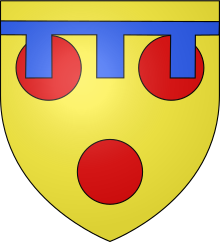Thomas Courtenay | |
|---|---|
| 5th or 13th Earl of Devon[2] | |
 | |
| Tenure | 16 June 1422 – 3 February 1458 |
| Other titles | 6th Lord Courtenay Baron of Okehampton |
| Born | 3 May 1414 Devon, England |
| Died | 3 February 1458 (aged 43) Abingdon Abbey, Oxfordshire, England |
| Residence | Okehampton Castle Tiverton Castle Colcombe Castle |
| Locality | Devon, Cornwall |
| Net worth | £1,516 (1422)[3] |
| Wars and battles | Hundred Years' War Bonville–Courtenay feud • Battle of Clyst Heath Wars of the Roses • 1st Battle of St Albans (WIA) |
| Offices | Steward of the duchy of Cornwall |
| Spouse(s) | Margaret Beaufort |
| Issue more... | Thomas, Earl of Devon John, Earl of Devon |
| House | Courtenay |
| Father | Hugh de Courtenay, 12th Earl of Devon |
| Mother | Anne Talbot |

Thomas de Courtenay, 5th/13th Earl of Devon (3 May 1414 – 3 February 1458) was a nobleman from South West England. His seat was at Colcombe Castle near Colyton, and later at the principal historic family seat of Tiverton Castle, after his mother's death. The Courtenay family had historically been an important one in the region, and the dominant force in the counties of Devon and Cornwall. However, the rise in power and influence of several gentry families and other political players, in the years leading up to Thomas' accession to the earldom, threatened the traditional dominance of the earls of Devon in the area. Much of his life was spent in armed territorial struggle against his near-neighbour, Sir William Bonville of Shute, at a time when central control over the provinces was weak. This feud forms part of the breakdown in law and order in England that led to the Wars of the Roses.
Courtenay was for a time engaged in overseas service during the Hundred Years' War.[4] Increasingly, however, his efforts became directed towards strengthening his position at home. He had been married off as an infant to Margaret Beaufort, placing Courtenay close to the English king's Beaufort kinsmen. Due to this connection, Courtenay started his career as an adherent to the English court's Beaufort party. Upon their demise in the late 1440s, he abandoned it in favour of Richard Plantagenet, 3rd Duke of York. When York sought the support of Courtenay's arch-enemy Bonville, Courtenay fell out of favour with him. When the Wars of the Roses broke out, he was in the party of the queen, Margaret of Anjou, and was one of the Lancastrian commanders at the First Battle of St Albans, where he was wounded.
Courtenay was said to have promoted a reconciliation between the Lancastrian and Yorkist parties, but he died suddenly in 1458. The Wars of the Roses later led to the deaths and executions of all three of Courtenay's sons, Thomas, Henry and John, and to the eventual attainder of his titles and forfeiture of his lands. The earldom was, however, revived in 1485 for his distant cousin, Sir Edward Courtenay, third in descent from his great-uncle.
- ^ Watson, Cokayne 1916, p. 324, footnote c: "This would appear more like a restitution of the old dignity than the creation of a new earldom"; Debrett's Peerage (Debrett 1968, p. 353) however gives the ordinal numbers as if a new earldom had been created.
- ^ The ordinal number given to the early Courtenay Earls of Devon depends on whether the earldom is deemed a new creation by the letters patent granted on 22 February 1335, or whether it is deemed a restitution of the old dignity of the de Redvers family. Authorities differ in their opinions,[1] and thus alternative ordinal numbers exist and are given here.
- ^ Cherry 2016.
- ^ Cokayne 1916, p. 326.